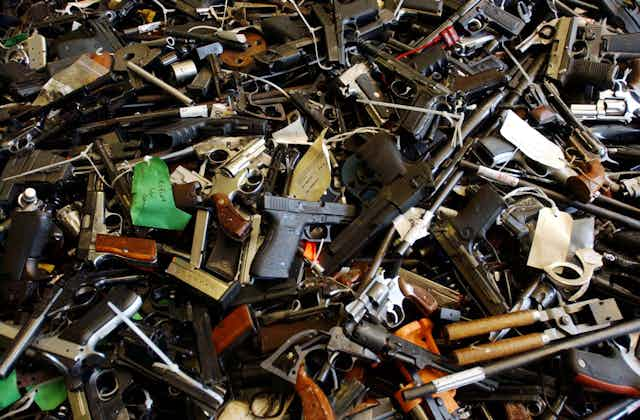The proud claim that Australia may have “solved the gun problem” might only be a temporary illusion. In recent years, arms dealers have imported more guns than ever before. And last year we crossed a symbolic threshold: for the first time in 20 years, Australia’s national arsenal of private guns is larger than it was before the Port Arthur massacre.
This increase must be seen in context. Australia’s population grew by five million in the same period, so per-capita firearm ownership remains 23% lower than it was before Port Arthur.
But after a 16-year surge in gun buying, can we hold onto the gains made by the laws introduced 20 years ago, after Martin Bryant’s rampage in Port Arthur killed 35 people?
The story so far
From the late 1970s, gun deaths in Australia have trended downwards. The risk of an Australian dying by gunshot remains less than half what it was before Port Arthur. Research shows that murderers did not move to other methods.
But although Australia hasn’t seen a public mass shooting since 1996, we have no shortage of firearm-related crime. Gun owners who know each other well – be they family members or gang members – have always been the ones to kill each other most frequently.
Then there’s the killer already in the room. About 80% of gun deaths in Australia have nothing to do with crime. Instead, they’re suicides and unintentional shootings.
Although Australia destroyed rapid-fire weapons, most gun deaths take only one shot. We have yet to discover how swapping semi-automatic weapons for single-shot firearms – always the most common tools in fatal shootings – might affect overall gun deaths in the long term. In fact, that’s largely what the change has been – a gun swap.
The 1996 firearm laws were immediately followed by a buying spree, as banned rapid-fire rifles and shotguns were replaced with freshly imported single-shot firearms.
By 1999, civilian gun imports had dropped to a record low. And most gun dealers closed their doors.
In the years that followed, gun-buying climbed steadily to new heights. By 2015, the arms trade had broken all previous records. Last financial year Australia imported 104,000 firearms.
The million guns destroyed after Port Arthur have been replaced with 1,026,000 new ones. And the surge only shows upward momentum.
More and more
But here’s the thing: fewer Australians now own guns. Since 1988, the proportion of households with a firearm fell by 75%.
The same holds true in the United States, where researchers now see household gun ownership as the most reliable indicator of firearm distribution.
The reason? Those who already possess several guns have bought more. Until recently, the average Australian shooter owned three to five firearms. The same people now keep a larger collection, and a proportion of their guns continue to leak into the illicit market.
Although rumours of large-scale gun smuggling to Australia are common, almost all such stories are evidence-free. Apart from an enterprising criminal band that ran a post office to import Glock pistols, no interdiction agency can point to a sizeable batch of guns smuggled to Australia since the 1980s.
Certainly, there’s an “ant trade” in single guns and parts smuggled by post. But studies by the Australian Crime Commission, the Institute of Criminology and several others point to a much more common source.
When guns found in crime are traced back to their point of origin, experts agree that most are found to have leaked from licensed gun owners and rogue firearm dealers. This is usually by way of the “grey market”, a large pool of illicit firearms created by Australian gun owners who did not register their firearms after the laws changed in 1996.
Australians continue to speak as though the 1996-97 Australian Gun Buyback was the key factor in the country’s national about-turn on guns. But several simultaneous, largely unheralded changes could have more effect in the long term.
In the 1996 National Firearms Agreement, Australia installed a holistic suite of firearm-related public health interventions. These spanned from compulsory firearm seizure in domestic violence cases to the requirement to show “genuine reason” for owning each firearm (now rolled back in several states); universal firearm registration; enforced safe storage regulations; definitive denial of the “right to bear arms”; and many others.
Dangerous backsliding
By my own analysis of 350 jurisdictions worldwide, Australia has in place the most comprehensive and perhaps the most effective mesh of gun control measures on the planet.
As no law is effective until taken seriously, enforcement and resistance to backsliding are now key. Realising the potential of our toughened firearm legislation, police have led two decades of national attitude adjustment reminiscent of the 1980s turnaround on drink-driving enforcement.
These days, dedicated gun-crime taskforces target armed career criminals; firearm-related prosecutions have have soared; police launch “nationwide blitzes” on gun owners’ homes and seize thousands of firearms; lethal weapons are removed from violence-prone or suicide-risk households; and actual sanctions are imposed on shooters who ignore safe storage regulations.
All this adds up to a new generation of police and political awareness.
But perhaps the most profound change has been in public attitude. At this 20th anniversary of the Port Arthur massacre, we’ve seen in media coverage a resurgence of public scepticism about the motives of self-interested groups seeking to wind back gun laws.
Dedicated, single-issue political potency remains theirs; surely we’re the only country in the world with two state political parties built and run by the gun lobby.
But in recent debates, we’ve seen little but reinforcement for the public health and safety measures forced on us two decades ago by the rampage of a solitary male, enabled with a couple of guns.
This article is part of a package marking the 20th anniversary of the 1996 Port Arthur massacre.

